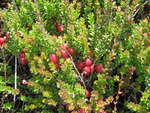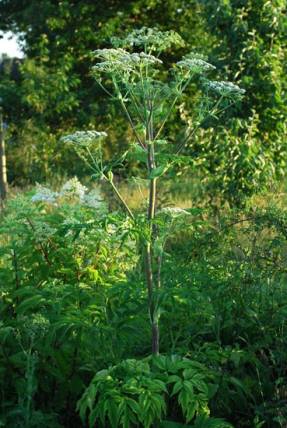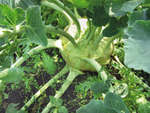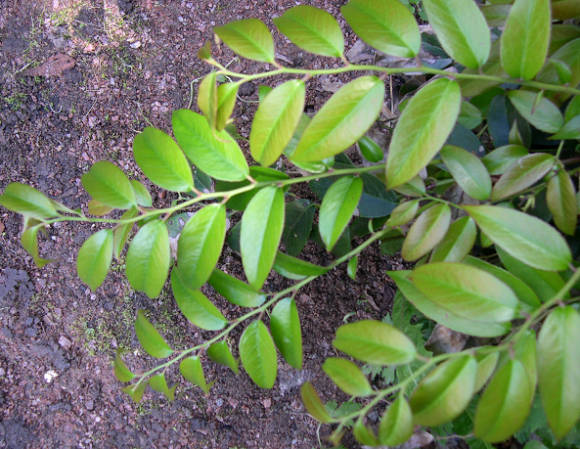 |
Epicactus were bred for the sake of their unusually beautiful flowers by crossing representatives of several genera of cacti from the Hilocereus tribe (Hylocereeae) family cactus (Cactaceae)... These are mainly representatives of the genera Disocactus, Pseudorhipsalis and Selenicereus, and only one species of the genus epiphyllum - serrated epiphyllum (Epiphyllum crenatum)... Therefore, the name "hybrid epiphyllums" is not entirely correct from a scientific point of view; rather, it reflects the hybrid origin of these plants and the epiphytic lifestyle of the original forms. In foreign sources, epicactuses are often denoted by the abbreviation EPIS. The progenitors of these hybrids live in the warm and humid forests of Central and South America, settling on tree trunks in hollows, sometimes in rock crevices, where rotted foliage accumulates. They are protected from the direct sun by the crown of trees. Plants are never exposed to low temperatures. In appearance, these cacti are sharply different from their desert relatives. Bare, practically without thorns, flat or round, strongly branching and often drooping, scalloped along the edge of the stems carry the function of photosynthesis, rather large flowers bloom in the modified buds - areoles. They were introduced to England in the middle of the 18th century. Since that time, in many European countries (England, Belgium, the Netherlands, France, Germany), work has begun on the breeding of new hybrid cacti. Some time later, at the end of the 18th century, they came back to America. Southern California's excellent climate has made it a major breeding center for these hybrids. The American Society of Epiphyllum Lovers (The Epiphyllum Society of America, ESA) was created, which maintains a list of hybrid forms and species of the Hilocereus tribe, and to date it contains more than 7000 names. Epicactuses inherit the best qualities of their parents, often acquiring special features. Varieties with white, yellow, salmon, orange, red, pink, cherry, lilac, purple and lavender colors have been bred, except perhaps blue flowers; some varieties are two-colored, when the outer and inner petals are contrasting in color, with color transitions; there is a wide variety in the degree of terry, the number of petals in the corolla. Flowers usually do not have such a long flower tube as true epiphyllums, but each flower is more durable, depending on the variety, it can last from 3 to 7 days, sometimes with a night scent. By flower size, all varieties are conditionally divided into several product groups: As a rule, flowering occurs in April-July, but there are earlier and later flowering varieties. In terms of the beauty of flowering, epicactus can compete with orchids, they are often called that - Orchid cacti, and therefore such hybrid forms are becoming more and more popular among flower growers. Modern hybrids are unpretentious in content and endow with amazing flowering. It is worth seeing him once to become a lifelong fan of these beautiful plants. Stems of epicactus are often flat, belt-like, abundantly branching and drooping, which makes it convenient to keep them in hanging baskets, but some varieties have partially triangular or faceted and erect stems. Although initially the task was not to develop varieties for home keeping, work in this direction is also underway. Unfortunately, the variety of hybrid epicactus that our flower shops offer is limited. But amateurs find opportunities to create large collections.Here are just a few of the interesting varieties that show the variety of shapes and colors of epicactus: Not only the appearance, but also the growing conditions sharply distinguish these epiphytic cacti from their desert relatives, therefore, care should be taken to adhere to conditions similar to those in which the original natural forms grow. Light preferable bright, diffused, as through a light shadow of foliage. With a lack of light, the plant will not bloom, its stems will become less wide, they will begin to acquire a faceted shape not only at the base of the shoot, which will lead to a loss of decorativeness. Good lighting is especially important in spring when flower buds are developing. In direct sun, the stems can get sunburn. Excessive illumination can be judged by the appearance of red pigment on the stems. Under normal light, the stems grow evenly along the entire length and are green in color. Priming loose, epiphytic, in composition resembling jungle soil, rotted leaf litter. Epicactus can grow with soil acidity from 5 to 9, but the optimal pH value is 6-7. When the pH rises above 8, plants will not be able to assimilate such important elements as iron, manganese, phosphorus. When the pH drops below 6, nitrogen, phosphorus and potassium will be poorly absorbed. When the pH drops to 4, the plant can be severely depressed. The standard soil from flower centers is balanced in terms of pH in the optimal range (6-7), so for preparing the mixture it is better to use purchased soil as a base, substrates for aroid or bromeliads are suitable, about a third should be coarse material that drains well and prevents soil caking (small fragments of bark, perlite). When watering with hard water, calcium and magnesium will gradually accumulate in the soil, they will shift the pH value to the alkaline side. This can be corrected by adding sphagnum, high-moor peat to the soil, or adding lemon juice (or other citrus fruits) to the irrigation water. It is better to take a small volume of the pot so that the not very developed bark system fills the entire space tightly. For a small cutting, a pot with a diameter of 8-10 cm will be enough, for a 2-3-year-old plant - 15 cm, for an adult large specimen, a pot with a diameter of 18 cm is maximum.Correct selection of the size of the pot and the composition of the soil will ensure the health of the roots and, accordingly, the entire plant. Watering... Water the plant regularly and in moderation during the summer, and keep the soil always slightly damp. Water with lukewarm water after the top layer of the soil has dried, without waiting for the entire volume to dry completely. And be sure to from above, and not from the pallet, be sure to remove excess water from the pallet after watering. Overdrying the coma has a detrimental effect on the condition of the roots, waterlogging or the choice of too heavy soil will lead to the fact that the air will not be able to approach the roots, and this will cause their decay. In winter, it is necessary to reduce watering, but still not bring the soil to dryness. As epiphytic plants, these cacti are adapted to partially absorb atmospheric moisture with all their stems and aerial roots, respond very well to spraying with lukewarm water (not in direct sunlight) at temperatures above + 18 ° C (spraying at lower temperatures is undesirable, this can cause fungal diseases ). Top dressing. Epicactuses don't need highdoses of fertilizers. During the winter rest, from November to February, all feeding should be canceled. After the plants wake up from sleep (February) and before the onset of the flowering period, they are fed with balanced fertilizers that do not contain nitrogen (NPK 0-10-10). The introduction of nitrogen fertilizers at this time can cause a refusal to bloom, instead of the development of flowers, vegetative growth will begin. As soon as the bud formation is over (usually in June) and until October, you can start applying nitrogen fertilizers (NPK 10-10-10). You can partially apply top dressing by foliar method, spraying the stems with a weak solution of fertilizers. Temperature... In summer, the optimum temperature for keeping epicactus is + 22 + 25 ° C. Epicactus do not tolerate heat well. During winter dormancy, from November to February, it is necessary to provide them with coolness (+ 12 + 16оС). These plants do not tolerate negative temperatures at all. Rest period in epicactus it begins around November and lasts until February. At this time, it is necessary to provide them with constant coolness, the temperature should not fall below + 12 ° C (up to + 7 ° C) and exceed + 16 ° C. An insulated loggia or a cool winter garden would be a suitable place. Since when the temperature drops, the metabolic rate also drops, the plants spend less energy to maintain themselves, you do not need to make them additional illumination (the cooler, the less light they can be content with). At this time, the frequency and abundance of watering decreases, but it is impossible to bring the lump to complete drying so that the roots do not suffer. Excessive soil moisture and a long drying time can lead to root rot. During rest, all dressings are canceled. With warm winter keeping, the stems will deform, young shoots will become thin and stunted, the plant will be exhausted and will not form flower buds. A full winter rest will promote abundant flowering. Reproduction. New varieties of epicatus are obtained from seeds obtained by crossing different species or already existing hybrids. A certain variety can only be propagated vegetatively, by rooting stem cuttings. To do this, take fragments of stems 10-15 cm long, for several days (from 3 cm in summer to 10 cm in winter, or depending on conditions) they are dried in the shade in the air. After that, oblique cuts are made from below towards the central vein, the cuts are powdered with dry Kornevin and the cuttings are several centimeters (usually 2-3 areolas), until they are stable, they are immersed in the ground. The composition of the soil includes sand and slightly acidic ready-made substrate in a 1: 1 ratio. The soil should be only slightly damp, not damp. For rooting cuttings, it is convenient to use transparent disposable cups of 100-200 ml (depending on the width of the stems), which have drainage holes from the bottom, or other small containers. Cuttings placed for rooting should not be placed in a greenhouse, where they can rot, but instead often sprayed with lukewarm water. Do not water for the first 7-10 days, until the soil is completely dry, then water very sparsely and from the pallet so that only the very bottom of the soil gets wet (the degree of soil moisture and the height of the water rise is well controlled in transparent cups). The next watering should be done in the same way and only after the soil dries out. Bottom watering will help the roots grow faster downward in search of water, the scarcity of watering will prevent the soil from getting too wet and the cuttings rotting. After about 3-4 weeks, rooting can be expected.In transparent cups, the growth of roots through the walls will be visible; in opaque containers, rooting can be judged by an increase in the thickness of the cuttings, the beginning of the growth of the crown or lateral shoots. From the moment the roots appear, start watering as usual from above. Bloom in plants grown from cuttings, it may occur in the second year, but the buds often fall off without opening. Stable flowering begins only from the third year of life, subject to care and cool wintering. Formation. If there is sufficient space, then the plant is allowed to grow freely in all directions, removing only deformed, old (since they gradually lose the ability to bloom) and disease-damaged shoots. Healthy shoots can be taken for grafting. The entire shoot should be removed so as not to spoil the appearance of the plant. Diseases and pests. With proper maintenance, epicactus practically do not get sick. Some varieties are susceptible to fungal disease, reddish-brown spots appear on the stems. The disease is often caused by too much humidity and low temperatures. In case of illness, you should urgently take several healthy cuttings from undamaged parts of the stem for the renewal of the variety. When kept outdoors in the summer, they are often attacked by slugs. At home, it is possible to be affected by a mealybug and scabbard. Photo by the author

Conditions of detention and care










